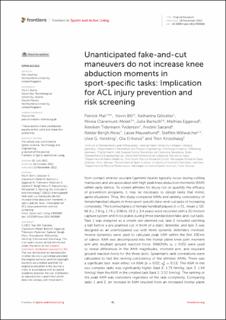| dc.contributor.author | Mai, Patrick | |
| dc.contributor.author | Bill, Kevin | |
| dc.contributor.author | Glöckler, Katharina | |
| dc.contributor.author | Claramunt-Molet, Mireia | |
| dc.contributor.author | Bartsch, Julia | |
| dc.contributor.author | Eggerud, Mathias M. | |
| dc.contributor.author | Pedersen, Anniken Tidemann | |
| dc.contributor.author | Sæland, Fredrik | |
| dc.contributor.author | Moss, Reidar Bergh | |
| dc.contributor.author | Mausehund, Lasse | |
| dc.contributor.author | Willwacher, Steffen | |
| dc.contributor.author | Eriksrud, Ola | |
| dc.contributor.author | Krosshaug, Tron | |
| dc.contributor.author | Kersting, Uwe G. | |
| dc.date.accessioned | 2023-01-11T10:01:14Z | |
| dc.date.available | 2023-01-11T10:01:14Z | |
| dc.date.created | 2022-11-25T15:46:14Z | |
| dc.date.issued | 2022 | |
| dc.identifier.citation | Frontiers in Sports and Active Living. 2022, 4, Artikkel 983888. | en_US |
| dc.identifier.issn | 2624-9367 | |
| dc.identifier.uri | https://hdl.handle.net/11250/3042623 | |
| dc.description | This is an open-access article distributed under the terms of the Creative Commons Attribution License (CC BY). The use, distribution or reproduction in other forums is permitted, provided the original author(s) and the copyright owner(s) are credited and that the original publication in this journal is cited, in accordance with accepted academic practice. No use, distribution or reproduction is permitted which does not comply with these terms. | en_US |
| dc.description.abstract | Non-contact anterior cruciate ligament injuries typically occur during cutting maneuvers and are associated with high peak knee abduction moments (KAM) within early stance. To screen athletes for injury risk or quantify the efficacy of prevention programs, it may be necessary to design tasks that mimic game situations. Thus, this study compared KAMs and ranking consistency of female handball players in three sport-specific fake-and-cut tasks of increasing complexity. The biomechanics of female handball players (n = 51, mean ± SD: 66.9 ± 7.8 kg, 1.74 ± 0.06 m, 19.2 ± 3.4 years) were recorded with a 3D motion capture system and force plates during three standardized fake-and-cut tasks. Task 1 was designed as a simple pre-planned cut, task 2 included catching a ball before a pre-planned cut in front of a static defender, and task 3 was designed as an unanticipated cut with three dynamic defenders involved. Inverse dynamics were used to calculate peak KAM within the first 100 ms of stance. KAM was decomposed into the frontal plane knee joint moment arm and resultant ground reaction force. RANOVAs (α ≤ 0.05) were used to reveal differences in the KAM magnitudes, moment arm, and resultant ground reaction force for the three tasks. Spearman's rank correlations were calculated to test the ranking consistency of the athletes' KAMs. There was a significant task main effect on KAM (p = 0.02; η2p = 0.13). The KAM in the two complex tasks was significantly higher (task 2: 1.73 Nm/kg; task 3: 1.64 Nm/kg) than the KAM in the simplest task (task 1: 1.52 Nm/kg). The ranking of the peak KAM was consistent regardless of the task complexity. Comparing tasks 1 and 2, an increase in KAM resulted from an increased frontal plane moment arm. Comparing tasks 1 and 3, higher KAM in task 3 resulted from an interplay between both moment arm and the resultant ground reaction force. In contrast to previous studies, unanticipated cutting maneuvers did not produce the highest KAMs. These findings indicate that the players have developed an automated sport-specific cutting technique that is utilized in both pre-planned and unanticipated fake-and-cut tasks. | en_US |
| dc.language.iso | eng | en_US |
| dc.subject | anterior cruciate ligament | en_US |
| dc.subject | anticipated | en_US |
| dc.subject | change of direction | en_US |
| dc.subject | cutting | en_US |
| dc.subject | handball | en_US |
| dc.subject | inverse dynamics | en_US |
| dc.subject | joint loading | en_US |
| dc.subject | sports medicine | en_US |
| dc.title | Unanticipated fake-and-cut maneuvers do not increase knee abduction moments in sport-specific tasks: Implication for ACL injury prevention and risk screening | en_US |
| dc.type | Peer reviewed | en_US |
| dc.type | Journal article | en_US |
| dc.description.version | publishedVersion | en_US |
| dc.rights.holder | © 2022 Mai, Bill, Glöckler, Claramunt-Molet, Bartsch, Eggerud, Tidemann Pedersen, Sæland, Bergh Moss, Mausehund, Willwacher, Kersting, Eriksrud and Krosshaug | en_US |
| dc.source.pagenumber | 10 | en_US |
| dc.source.volume | 4 | en_US |
| dc.source.journal | Frontiers in Sports and Active Living | en_US |
| dc.identifier.doi | 10.3389/fspor.2022.983888 | |
| dc.identifier.cristin | 2081444 | |
| dc.description.localcode | Institutt for idrettsmedisinske fag / Department of Sports Medicine | en_US |
| dc.description.localcode | Institutt for fysisk prestasjonsevne / Department of Physical Performance | en_US |
| cristin.ispublished | true | |
| cristin.fulltext | original | |
| cristin.qualitycode | 1 | |
